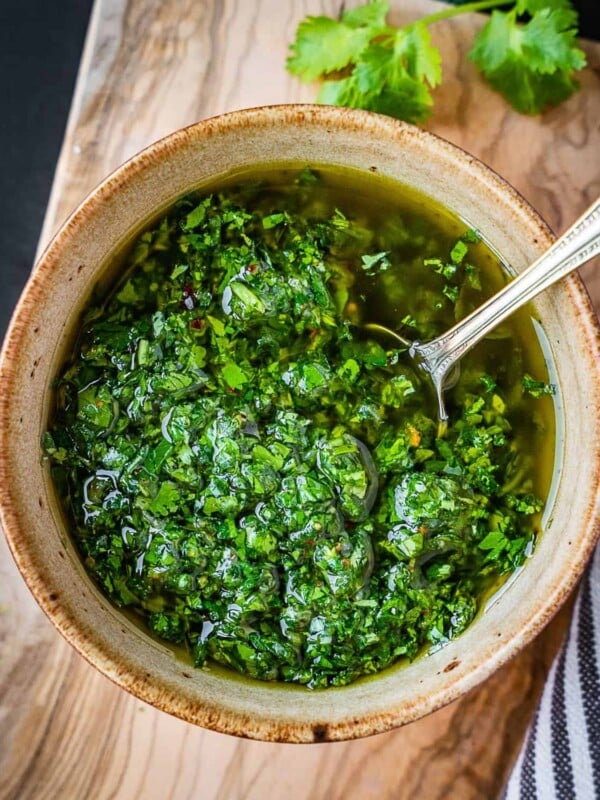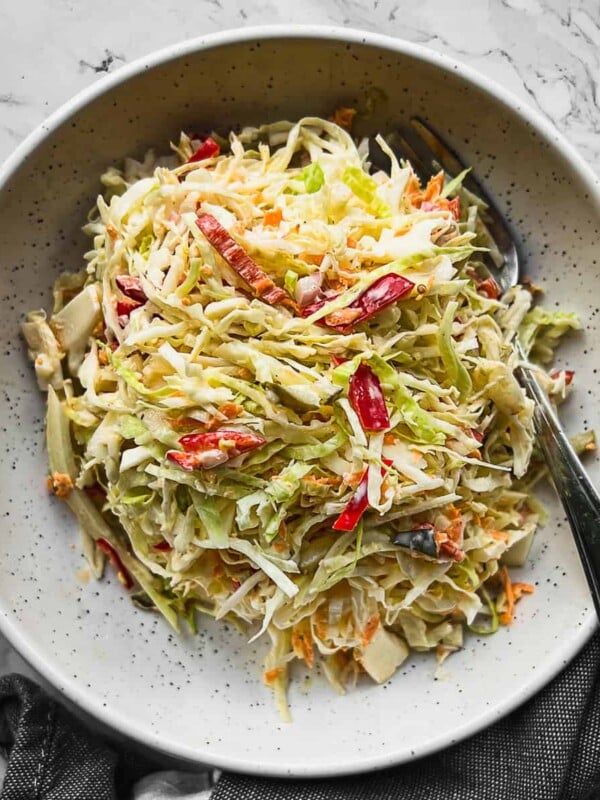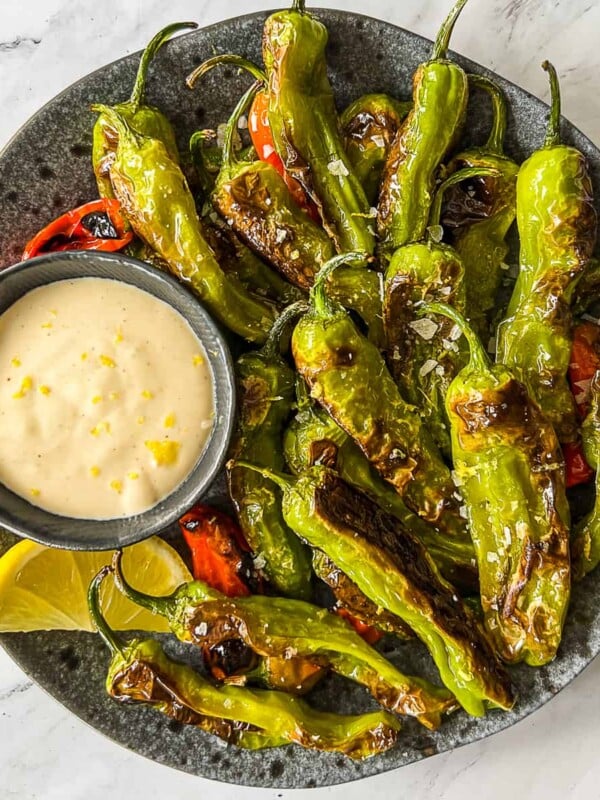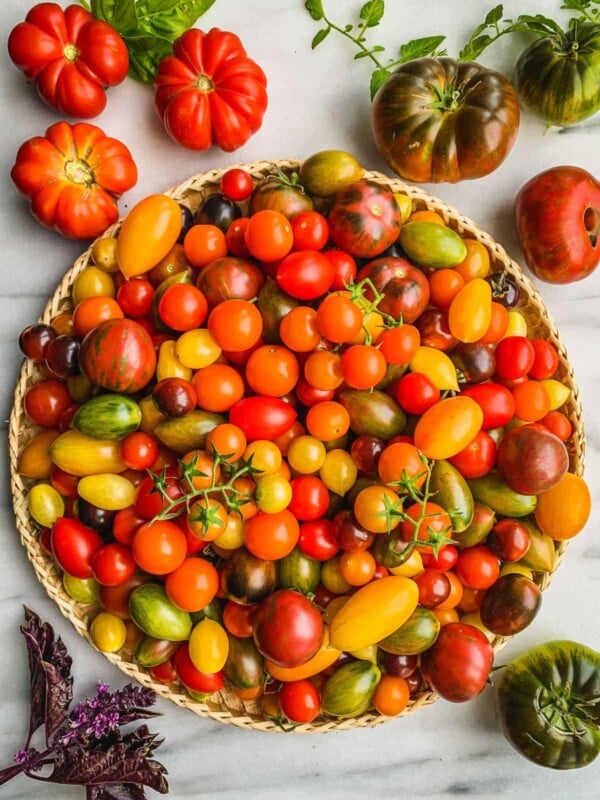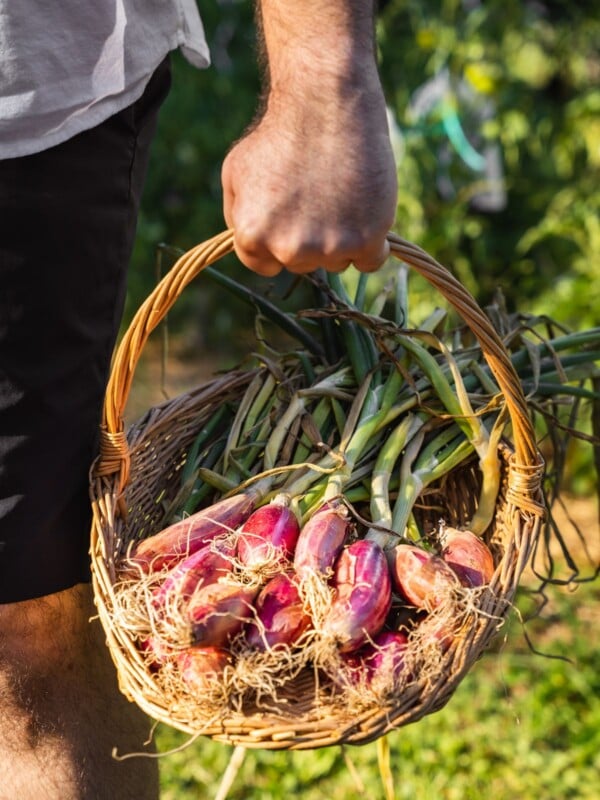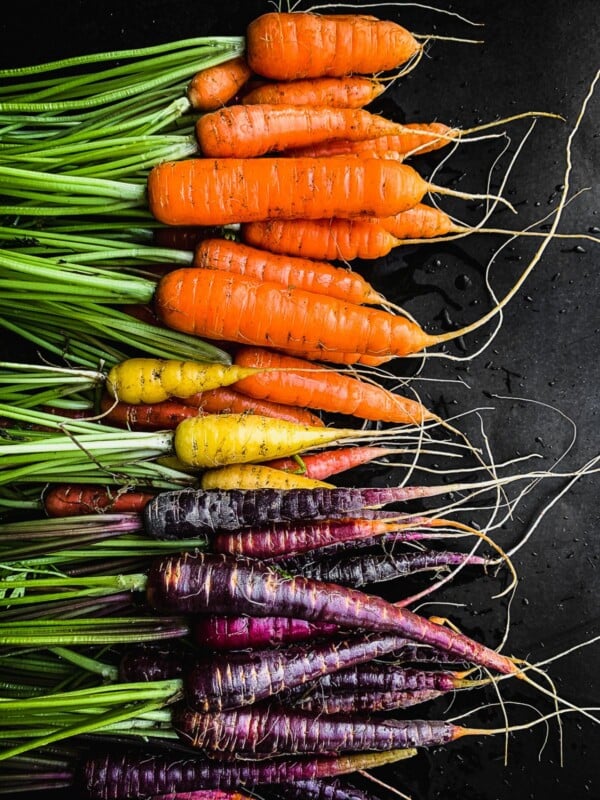Peppers are a staple in many gardens and kitchens around the world (including mine!). Loved for their unique flavors and varying levels of heat, peppers are a versatile ingredient that has many uses. From mild and sweet to fiery and intense, there is a vast array of pepper varieties to choose from, each with its own distinct characteristics and uses.

Table of Contents
In this blog post, I will explore some of the most popular pepper peppers, including their scientific names, Scoville heat unit levels, and flavor profiles. I have grown every single one of these peppers in my urban backyard. I have cooked with them, dried them, fermented them and pickled them.
Whether you’re a seasoned chef or a curious home cook, read on to learn more about the wonderful world of peppers and how to incorporate them into your garden and kitchen. Growing your own is a great way to go beyond what’s available at the grocery store.
My book, Seed to Table, includes a Pepper Growing Guide as well as some recommended varieties and recipes that feature peppers.
Pepper Species
There are 5 different species of peppers cultivated in the world.
- Capsicum annuum (c. annum) – This is the most commonly cultivated and consumed species within the Capsicum genus, and includes a wide range of pepper varieties, such as bell peppers (sweet peppers or green peppers), cubanelle pepper, jalapenos, cayenne peppers, and more. Capsicum annuum peppers are typically mild to moderately spicy, with a range of flavors that can vary from sweet and fruity to tangy and smoky.
- Capsicum chinense (c. chinense) – This species includes some of the hottest peppers in the world, such as the famous Carolina Reaper and Trinidad Scorpion. They are sometimes referred to as “super-hot peppers”. Capsicum chinense peppers are typically very spicy, with a fruity, floral flavor that sets them apart from other pepper species. They are commonly used in Caribbean and Latin American cuisine.
- Capsicum frutescens (c. frutescens) – This species includes peppers such as tabasco and bird’s eye chilies. Capsicum frutescens peppers are typically small and very spicy, with a bright, pungent flavor that can be used to add heat and depth to a variety of dishes.
- Capsicum baccatum (c. baccatum)- This species includes peppers such as aji amarillo and aji cristal. Capsicum baccatum peppers are typically mild to moderately spicy, with a fruity, slightly sweet flavor that can be used in a range of dishes, from sauces to soups to grilled meats and vegetables.
- Capsicum pubescens (c. pubescens)- This species includes peppers such as rocoto and manzano. Capsicum pubescens peppers are typically very spicy, with a unique, fruity flavor and a thick, fleshy texture. They are commonly used in Andean cuisine and can be roasted, stuffed, or used to make sauces and condiments.
What is the Scoville Heat Unit?
The Scoville Heat Unit (SHU) is a measurement scale for the hotness of peppers. It was created by American pharmacist Wilbur Scoville in 1912 to measure the level of heat produced by different varieties of chili peppers. The scale assigns a numerical value to the concentration of capsaicin, the compound responsible for the spicy sensation, in a pepper.
The SHU scale ranges from 0 to 16 million, with 0 representing no heat and 16 million being the highest concentration of capsaicin ever recorded in a chili pepper. To determine the SHU value, a panel of trained tasters samples the chili pepper and dilutes it in sugar water until the heat is no longer detectable. The degree of dilution is used to assign a numerical value to the chili pepper.

The Scoville scale is widely used by food manufacturers to rate the spiciness of their products and to help consumers choose products that suit their taste preferences. It is also used in scientific research to study the effects of capsaicin on the human body, including its potential health benefits and therapeutic uses.
In recent years, the Scoville scale has faced criticism for its subjective nature and lack of precision. As a result, alternative methods for measuring capsaicin concentration have been developed, including high-performance liquid chromatography (HPLC) and gas chromatography-mass spectrometry (GC-MS). Despite this, the Scoville scale remains a popular and recognizable tool for measuring the spiciness of chili peppers and other spicy foods.
What’s the difference between chile and chili pepper?
The words “chile” and “chili” both refer to a spicy pepper, but the spelling and usage of the words vary depending on the context, and language spoken and location.
In general, “chile” (pronounced chee-lay) is the term used in Latin America and the southwestern United States to refer to a specific type of pepper that is typically long and narrow with a medium heat level. These peppers are commonly used in traditional dishes such as chile rellenos and mole sauce.

The words “chile” and “chili” can be used interchangeably. For example, a recipe might call for “chile powder” or “chili powder,” both of which typically contain ground chile peppers mixed with other spices. Similarly, a person might refer to a spicy pepper as a “chile” or a “chili pepper” depending on their regional or personal preference.
For me personally, I will typically use the word “chile” when referring to a pepper from Mexico, Central America, South America or even from New Mexico or California.
List of Pepper Varieties
The following list of my 33 Best Types of Pepper Plants to Grow in Your Garden grouped by the 5 different species. These varieties will all grow really well in the ground, in raised bed gardens or containerin gardens.
Capsicum chinense (c. chinense)
Aji Charapita Pepper
Scientific Name: Capsicum chinense
30,000-50,000 SHU
The Aji Charapita pepper is a small, very spicy pepper with a fruity, citrusy flavor. It has a heat level that ranges from 30,000 to 50,000 Scoville heat units. It is used in Peruvian cuisine to add heat to dishes, or as a seasoning for sauces.
This pepper variety grows on small compact bushes and as such can be grown indoors. What I love about this variety is that a little goes a long way. The small pencil-eraser sized peppers pack a punch, so there’s little waste when preparing them.

Aji Chombo Pepper
Scientific Name: Capsicum chinense
100,000-350,000 SHU
The Aji Chombo pepper is a small, very spicy chili pepper commonly used in Panamanian cuisine. It has a fruity, slightly sweet flavor with a heat level that ranges from 100,000 to 350,000 Scoville heat units. They are often used in hot sauces and as a spicy seasoning for meat dishes.

Aji Limon Pepper
Scientific Name: Capsicum chinense
30,000-50,000 SHU
The Aji Limon pepper, also known as the lemon drop pepper, is a small, yellow chili pepper with a citrusy flavor. It is commonly used in Peruvian cuisine in ceviche, salsas, and sauces. I have also used them to season Traditional Chimichurri or Cilantro Chimichurri.
Because of their thin walls, I have used this pepper to make powders and flakes as it dehydrates quite well. As it dries, the color changes slightly from bright yellow to light orange.

Scotch Bonnet Pepper
Scientific Name: Capsicum annuum
Scientific Name: Capsicum chinense
100,000-350,000 SHU
The Scotch Bonnet pepper is a small, spicy chili pepper commonly used in Caribbean cuisine. It has a fruity, sweet flavor but don’t let that fool you. They pack a punch! They are used in jerk seasonings, sauces, and marinades.

Ghost Pepper
Scientific Name: Capsicum chinense
855,000-1,041,427 SHU
The Ghost Pepper, also known as Bhut Jolokia, is a small, extremely spicy chili pepper from India. It has a slightly sweet, fruity flavor with a very intense heat level that can be a challenge for the taste buds. They are often used in hot sauces and as a seasoning for spicy dishes.

Habanero Pepper
Scientific Name: Capsicum chinense
100,000 – 350,000 SHU
The Habanero pepper is a small, lantern-shaped chili that is typically orange, red, or yellow in color. It is one of the spiciest chili peppers and is known for its fruity, slightly sweet flavor with intense heat. It is often used in Caribbean, Mexican, and Central American cuisines in salsas, marinades, and hot sauces.
Try my Mango Habanero hot sauce and Passionfruit Habanero hot sauce.
There are new hybrids available now that have all the flavor of the habanero without the heat. One such variety is the Habanada.

Puma Pepper
Scientific Name: Capsicum chinense
100,000-200,000 SHU
The Puma pepper is a small, very spicy chili pepper with a fruity and slightly floral flavor. The color is a combination of orange and deep purple. They are often used in hot sauces and as a seasoning for spicy dishes.
The plants are incredibly ornamental with beautiful purple foliage. This pepper variety is a must-grow if you love hot peppers but are also looking to incorporate beautiful foliage in your garden design.

Capsicum baccatum (c. baccatum)
Aji Amarillo Pepper
Scientific Name: Capsicum baccatum
30,000-50,000 SHU
The Aji Amarillo pepper is a bright orange, medium-sized chili pepper that is commonly used in Peruvian cuisine. It might even be the national pepper of Peru! It has a fruity, slightly sweet flavor with a heat level that ranges from 30,000 to 50,000 Scoville units. Aji Amarillo is used in sauces, stews, and to season ceviche. It can be blended with oil to create an Aji Amarillo sauce for dipping.
These are tall plants and can be difficult to manage. Proper trellising or staking is needed.

Sugar Rush Peach
Scientific Name: Capsicum baccatum
50,000-100,000 SHU
I have loved growing Sugar Rush Peach for a few reasons. The plants themselves are incredibly ornamental and the beautiful peppers just look great as they hang. The vines are incredibly prolific.
As the fruit sets, it turns from light green to light yellow. You know they are ready to harvest when they turn from light yellow to light peach. The color change is quite subtle.
They are great for making fermented hot sauce or for drying.

Capsicum annuum (c. annum)
Aleppo Pepper
Scientific Name: Capsicum annuum
10,000-30,000 SHU
The Aleppo pepper is a medium-spicy chili pepper commonly used in Middle Eastern and Mediterranean cuisine. As the name suggests, it originates in Aleppo, Syria. It has a fruity, slightly smoky flavor with a heat level that ranges from 10,000 to 30,000 Scoville heat units. They are used to season meat dishes, hummus, and other dips. I use this pepper to season Turkish Eggs, a perfect brunch meal, and Labneh Balls.

This might be one of my favorite peppers and not because I happen to be from that part of the world. Aleppo peppers are typically dried and ground into coarse flakes. The color of dried Aleppo pepper is deep red and the flavor is delicious.
Anaheim Pepper
Scientific Name: Capsicum annuum
Scoville Heat Unit: 500-2,500 SHU
The Anaheim pepper is a mild to medium chili pepper that is commonly used in Mexican and Southwestern cuisine. They are usually green when unripe and turn red when fully mature. They have a mild, slightly sweet flavor with a heat level that ranges from 500 to 2,500 Scoville heat units.
In its dry form, the Anaheim pepper is known as the Colorado pepper! Go figure!

Banana Pepper
Scientific Name: Capsicum annuum
Scoville Heat Unit: 0-500 SHU
The sweet Banana pepper is a sweet, mild pepper that is commonly used as a pickled or grilled condiment in sandwiches, pizzas, and salads. They are usually yellow when ripe and have a slight curve to their shape. Banana peppers have a sweet flavor and a heat level that ranges from 0 to 500 Scoville heat units.
This is a great variety for beginner gardeners as the plants are commonly available in garden centers and nurseries in the spring. The vines are productive and easy to maintain. Try my pickled banana pepper recipe.
Blot Pepper
Scientific Name: Capsicum annuum
0 SHU
What a fun and striking variety. Blot is a sweet bell type with purple and yellow markings. As the peppers ripen, the light yellow will turn slightly darker. This is a very nuanced change, almost undetectable. The good news is that you can harvest these peppers at any time, as they are quite sweet.

Buena Mulata Pepper
Scientific Name: Capsicum annuum
2,500-4,000 SHU
The Buena Mulata pepper is a medium-mild chili pepper with a sweet, smoky flavor. It has a heat level that ranges from 2,500 to 4,000 Scoville heat units. It is used in Latin American cuisine, especially in sauces, stews, and salads.
What makes this pepper so unique is its beautiful purple color. As it ripens, the color changes from purple to red. It can be treated just like a cayenne pepper.

California Wonder Pepper
Scientific Name: Capsicum annuum
0-1,000 SHU
The California Wonder pepper is a large, mild pepper with thick walls commonly used across the world. It has a sweet, slightly tangy flavor with no heat. They are used in salads, such as my Jerusalem Chopped Salad, sandwiches, and as a stuffing pepper. They can also be used in Fermented Hot Sauce and Shatta (Middle Eastern Chili Paste) to balance the heat from hot chilis.
California Wonder can be picked early (green bell pepper) or allowed to mature and ripen (red).

Carolina Reaper Pepper
Scientific Name: Capsicum chinense
1,400,000-2,200,000 SHU
The Carolina Reaper pepper is a small, extremely spicy chili pepper that held the Guiness world record for the hottest pepper for a few years. It has a fruity, slightly sweet flavor with an intense heat level that ranges from 1,400,000 to 2,200,000 Scoville heat units. They are often used in hot sauce and as a challenge for pepper lovers.
Personally, I try to stay away from growing super-hots. The novelty wears off quickly so unless you truly love spicy food or making your own killer hot sauce, you can skip these super hots.
Cayenne Pepper
Scientific Name: Capsicum annuum
Scoville Heat Unit: 30,000-50,000 SHU
The Cayenne pepper is a thin, red chili pepper commonly used to add heat and flavor to various dishes, such as soups, stews, and sauces. It has a long, slender shape and a very manageable heat level. It has a slightly sweet and smoky flavor.
This variety is used to make pepper flakes and powders. The plants are robust and prolific, making them a great hot pepper variety to grow in the home garden.

Chocolate Habanero Pepper
Scientific Name: Capsicum chinense
425,000-577,000 SHU
The Chocolate Habanero pepper is a small, extremely spicy chili pepper with a deep brown color. It has a smoky, slightly fruity flavor but don’t let the color and shape fool you. This is a spicy one! They are often used in hot sauces and as a seasoning for meat dishes.

Corbaci Pepper
Scientific Name: Capsicum annuum
5,000-30,000 SHU
The Corbaci pepper is a medium-spicy chili pepper from Turkey. It has a slightly sweet, smoky flavor. They are often used in Turkish cuisine to make a spicy paste, or as a seasoning for grilled meats and vegetables.

Fresno Pepper
Scientific Name: Capsicum annuum
Scoville Heat Unit: 2,500-10,000 SHU
The Fresno pepper is a medium-sized chili pepper that is commonly used as a substitute for jalapeño peppers. They have a slightly sweeter flavor and a manageable heat level. They are typically red or green and can be used fresh or dried in a variety of dishes, such as salsas, sauces, and marinades.

I love growing Fresno peppers. The plants are usually very prolific and the fruits ripen quickly.
Guajillo (Marisol) Pepper
Scientific Name: Capsicum annuum
2,500-5,000 SHU
The Guajillo pepper is a medium-mild chili pepper commonly used in Mexican cuisine. It has a slightly sweet and tangy flavor. Typically, this pepper is dried and then used to make sauces, moles, salsas, soups, and stews.

What’s confusing about the naming convention of this pepper is that Guajillo refers to the pepper in its dry form, whereas Marisol refers to the pepper in its fresh form. Generally speaking, though, in North America, we refer to this pepper as a Guajillo (for both fresh and dried forms).
Try my Salsa Macha, Harissa Paste, and Salsa Roja recipes which use dried Guajillo peppers.
Jalapeño Pepper
Scientific Name: Capsicum annuum
2,500-8,000 SHU
Who doesn’t know this versatile workhorse of a pepper? The Jalapeño pepper is a medium-sized chili pepper that is commonly used in Mexican cuisine (but is now used across the world). It is used in salsas, sauces, and stuffed with cheese or meat. Try my Peach Tomatillo Salsa, Avocado Salsa, Roasted Tomatillo Salsa, quick pickled jalapenos and fermented jalapenos recipes.
Jalapenos are typically harvested when they are still green. You can let them ripen on the vine (they will turn red). Red jalapenos are traditionally smoked and dried. In this form, they are called Chipotle. See my Salsa Macha, Chipotle Hot Sauce and Creamy Chipotle Sauce recipes!

Jimmy Nardello Pepper
Scientific Name: Capsicum annuum
100-1,000 SHU
The Jimmy Nardello pepper is a type of sweet Italian frying pepper with a thin skin, long and tapered shape, and a bright red color when fully ripe. The pepper is named after Jimmy Nardello, the son of Italian immigrants who brought the seeds with them from the town of Ruoti in southern Italy to the United States in the late 19th century.

I love growing these because the vines are prolific and the peppers can be used in salads, added to pickles and ferments, or served alongside meat and cheese on a charcuterie board. They are featured in my sweet-and-sour pickled sweet pepper recipe!
Padrón Pepper
Scientific Name: Capsicum annuum
500-2,500 SHU
The Padrón pepper is a small, mild chili pepper commonly used in Spanish cuisine. It has a sweet, slightly smoky flavor. These peppers are often grilled or pan-fried and served as part of a tapas spread. They are similar to shishito peppers and cooked/prepared the same way. Have you tried my Blistered Shishito Pepper recipe yet?
They are spicier than shishitos so if you’re looking for a milder snacking or frying pepper, go for the shishito!
Rezha Macedonian Pepper
Scientific Name: Capsicum annuum
5,000-30,000 SHU
The Rezha Macedonian pepper is a medium-spicy chili pepper from Macedonia. It has a slightly sweet, smoky flavor. What makes this pepper so unique is its appearance. As they grow, they start showing stretch marks (also known as corking). These stretch marks occur because the fruits are growing too quickly. They could also be a result of stress or irregular watering. Some varieties are just genetically disposed to this.
They are often used to make a spicy paste, or as a seasoning for grilled meats and vegetables. I also like to dry them and turn them into flakes or powders.

Serrano Pepper
Scientific Name: Capsicum annuum
10,000-23,000 SHU
The Serrano pepper is a small, thin chili pepper commonly used in Mexican cuisine. It has a bright, spicy flavor. They are often used in salsas, sauces, and guacamole. I personally prefer them over Jalapenos. They are quite versatile. Try my Peach Tomatillo Salsa, Pickled Serrano Peppers or my Roasted Tomatillo Salsa recipes.

Poblano Pepper
Scientific Name: Capsicum annuum
1,000-1,500 SHU
The Poblano pepper is a large, mild chili pepper commonly used in Mexican cuisine. It has a slightly sweet, smoky flavor with a heat level that ranges from 1,000 to 1,500 Scoville heat units. They are often stuffed with cheese or meat and served as a main course (chiles rellenos).
In its dry form, the poblano is known as Ancho..

Purple Beauty
Scientific Name: Capsicum annuum
0-500 SHU
The Purple Beauty pepper is a mild chili pepper with a deep purple color. It has a sweet, slightly fruity flavor. They are often used in salads or as a colorful garnish. It’s essentially a purple bell pepper. What’s not to love?

Shishito Pepper
Scientific Name: Capsicum annuum
50-200 SHU
The Shishito pepper is a small, mild chili pepper commonly used in Japanese cuisine. It has a slightly sweet and smoky flavor. They are often grilled or pan-fried and served as a snack or appetizer.
There’s a saying, out of 10 Shishito peppers, one will be spicy. I have experienced this myself so I can definitely say there’s merit to this saying! I also find the peppers tend to be spicier as they ripen to red. Have you tried my Blistered Shishito Pepper recipe yet?
Tip: Harvest regularly! The more you harvest, the more peppers the vines will produce.

Pasilla Pepper (Chilaca)
Scientific Name: Capsicum annuum
1,000-2,000 SHU
The Pasilla (Chilaca) pepper is a mild chili pepper commonly used in Mexican cuisine. It has a rich, smoky flavor. It is often used to make sauces, soups, and stews, and are sometimes dried and used to make chili powder.
What’s confusing about the naming convention of this pepper is that Pasilla refers to the pepper in its dry form, whereas Chilaca refers to the pepper in its fresh form. Generally speaking though, in North America, we refer to this pepper as a Pasilla (for both fresh and dried forms).
Gochujang Pepper
Scientific Name: Capsicum annuum
1,500-10,000 SHU
The Gochuchang pepper is a mild chili pepper commonly used in Korean cuisine. It has a slightly sweet, smoky flavor with a heat level that ranges from 1,500 to 10,000 Scoville heat units. It is often used to make the spicy, fermented paste of the same name.
Capsicum pubescens (c. pubescens)
Rocoto Pepper
Scientific Name: Capsicum pubescens
50,000-250,000 SHU
The Rocoto pepper is a medium-sized chili pepper commonly used in Peruvian and South American cuisine. It has a fruity, slightly sweet flavor with a heat level that ranges from 50,000 to 250,000 Scoville heat units. They are often used in salsas, sauces, and stews.
What’s really interesting about this variety is the color of the seeds. Most pepper seeds are white whereas the seeds of the rocoto are back. The vines of the rocoto pepper are also quite unique (hairy) and the flowers look slightly different than other pepper types.

Capsicum frutescens (c. frutescens)
Thai Bird Chili
Scientific Name: Capsicum frutescens
50,000-100,000 SHU
The Thai Bird Chili, also known as Bird’s Eye Chili, is a small, thin chili pepper commonly used in Thai and other Southeast Asian cuisines. These Thai peppers are often used in stir-fries, curries, condiments like sambal and other sauces. I like to dry it and crush it into flakes. I’ve also used them to season Traditional Chimichurri or Cilantro Chimichurri.

My book, Seed to Table, includes a pepper growing guide as well as many recipes to inspire you.
Recipes that Feature Peppers
Breakfast
Preservation
Appetizers
Appetizers
Make sure to also check out my 17 best tomatoes for container gardening, 13 best eggplant varieties to grow as well as my top tomato vareities to grow posts.
I hope that you enjoyed this list. For more gardening advice, follow along on Instagram, Facebook, and Pinterest, visit the Urban Farm Shop, or subscribe for new posts via email.
The most common species is Capsicum annuum. It includes many well-known varieties including jalapenos and bell peppers. Capsicum Chinense includes spicy varieties like the Carolina Reaper. Capsicum Frutescens includes fruity and spicy varieties like the Thai Chili. Capsicum Baccatum includes important varieties like the Aji Amarillo. Capsicum Pubescens includes varieties like the rocoto and manzano.
Officially known as corking, these stretch marks occur because the pepper fruits are growing too quickly. They could also be a result of stress or irregular watering. Some varieties are just genetically disposed to this (for example, the Rezha Macedonian and Jalapeno pepper).
The words “chile” and “chili” both refer to a spicy pepper, but the spelling and usage of the words vary depending on the context, and language spoken and location. In general, “chile” (pronounced chee-lay) is the term used in Latin America and the southwestern United States to refer to specific types of peppers commonly used in traditional dishes such as chile rellenos and mole.

